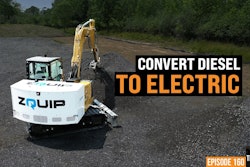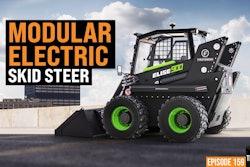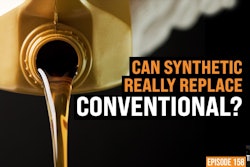If you’ve ever seen scrapers in action, you know how fast they can move dirt.
They come in two main varieties: self-propelled and pull-type.
On this episode of The Dirt, we hear about the benefits of pull-type scrapers from K.A. Group, owner of K-Tec, Ashland and Metalcraft brands.
Compared to self-powered scrapers, towable models cost less to purchase, require less maintenance and protect resell value, according to our guest, Shane Kroeker, K.A. Group director of strategic initiatives. They also offer advantages over traditional excavator-haul truck operations you might not have considered.
The K.A. brands offer a variety of sizes of scrapers, from those that can be pushed by compact track loaders to the large models that can be pulled by articulated dump trucks – even towing more than one scraper at a time.
So to find out more about how pull-type scrapers can benefit your earthmoving operations, check out the latest episode of The Dirt.
Equipment World serves up weekly videos on the latest in construction equipment, work trucks and pickup trucks – everything contractors need to get their work done. Subscribe and visit us at equipmentworld.com!
In This Episode:
- 00:00 - K.A. Group Scrapers
- 00:39 - What Kind of Scrapers Does K.A. Group Offer?
- 01:38 - Towable Scrapers vs. Traditional Motor Scrapers
- 05:42 - How Difficult is it to Convert an ADT to Tow a Scraper?
- 09:33 - Do Towable Scrapers Perform Better?
- 10:51 - Why Use Scrapers Instead of Dump Trucks with an Excavator?
- 13:14 - Final Thoughts
Bryan Furnace (00:00):
Today, we're here to talk about scrapers, but not the big self-powered units. We're here to talk about the pull-pans. If you're not familiar with K.A. Group, you will be here soon. They are the manufacturers of the product lines of K-Tec, Ashland, and Metalcraft: three different product lines that serve different areas of the industry. Shane is here to talk with us today about all three product lines and what they can possibly do for your company.
(00:38):
So my first question is: For those not familiar with K.A. Group's kind of product line, can you give us an overview of the product line and then the industries that they serve, the different segments?
Shane Kroeker (00:49):
Absolutely, yeah. So the K.A. Group is comprised of three brands. We have the K-Tec brand, the Ashland brand, and Metalcraft. So the K-Tec brand is very much focused in the heavy construction, mining, quarrying industry. Really robust machines, premium product, a three-year structural warranty on those heavy-duty scraper equipment.
(01:10):
The Ashland brand is more so in the industrial construction, we'd call it, as well as the agriculture sector as well. Nice solid one-year warranty on that.
(01:19):
Metalcraft brand: Again, that's a little bit more of a niche market there. It's more catered towards the land-leveling contractors. Really popular in that Southern Mississippi Delta area as well.
(01:28):
So those are our high-level three different brands that we have under the K.A. Group.
Bryan Furnace (01:33):
Gotcha. So one of the questions I've always wondered is what are some of the advantages behind these standalone pull-behind pans, versus the traditional scrapers that everybody knows in the industry that are self-powered units?
Shane Kroeker (01:48):
One of the major advantages that we have is that it's really a lower capital investment. You can get in a full scraper machine attached to a tractor or a truck at a lower capital investment than the traditional self-powered motor scrapers in the market, so that's one of the major advantages there. You can move a lot of dirt. You've got less maintenance as well, so that's the other benefit to the machines too. Very few grease points. We want to have you moving dirt as fast as you can, instead of having to constantly maintain those machines too. So that's one of the major benefits there too.
(02:19):
Another unique way that we can use our machines is that you can actually split our machines up so we're not connected as a purpose-built scraper machine. We have the pull-pan plus the power unit, so you can actually split those apart, and then you have a minimal downtime in that, actually, as well. So if your tractor or your truck is down, you can swap it out with a different power unit and get on moving as well. So that's one of the other major advantages there.
(02:44):
And then circling all in all, you're looking at a better resale value at the end of your investment, as well, because you can again split those machines up, sell the scraper separately, sell the truck or tractor separately, instead of having this one purpose-built machine that really depreciates over time. And it's hard to really get that extra value out of those machines, as well, as you see, at the end of life.
Bryan Furnace (03:07):
Do you have other ways that these units showcase the flexibility of what you can do by going this route, as opposed to a dedicated self-powered scraper?
Shane Kroeker (03:16):
Absolutely, yeah. I like to think of the K-Tec 1237 ADT as really the modern-day transformer machine because it's a bolt-together design, a really flexible, versatile unit. What you can do with this is that you can actually hook up to your existing rock truck that you have in your fleet. It doesn't matter for us if you have a Cat, ADT, Komatsu, Volvo, Rokbak. Doesn't matter; we have hitching systems for any of them, so you've already got that flexibility for that setup. Now you can turn it into a scraper-hauler that has essentially one operator, one engine running, that can move dirt themselves. You don't need to wait for this idle time and anything like that for an excavator to be a loader. You can take care of it yourself. Great advantages there.
(03:57):
So the other unique advantage of this 1237 is actually if you have the appropriate haul length and loading area, you can actually tandem them up, train a couple of these together. So now you got 72 cubic yards behind this one power unit, so now you're really moving dirt. So huge flexibility there too.
(04:17):
And the other advantage, too, is actually the center hitch pull, the gooseneck hitch pull, could be removed, as well, and you could bolt in a direct-mount hitch pull in there too. So if you have a tractor or a dozer on-site too, you can actually use that as a power unit now to swap in your scraper as well.
(04:33):
So huge advantages, lots of flexibility, and we have customers that love that flexibility to be able to use whatever they have to be able to move dirt with those applications. So really exciting stuff that we've got going on.
Bryan Furnace (04:46):
Yeah, that's one of our big things as dirt contractors, is you get into the field, and these days, it's very hard to buy a one-use specific tool because there's just so many variables on the job site. You need to have the flexibility to change your day around and shuffle accordingly. If you've bought something like a self-powered scraper, that's a one-trick pony. It's only going to do that, and unfortunately, you can't do anything else with it. But this, man, there's a ton of versatility there. That's such an advantage.
Shane Kroeker (05:16):
Absolutely, yeah, you see it again and again. Even if you look at the calendar, you can't always necessarily use the self-propelled scrapers year round. So if you can use your ADT truck as basically a power unit for scraping, once it gets to the rainy season, switch it back on, dump it on. You can use that with your excavators and load up and still have a useful asset there as well. So a lot of flexibility, lots of versatility that contractors should be looking at these days.
Bryan Furnace (05:41):
Another thing I've always been curious about with these units: So let's say I modify one of my articulated dump trucks to pull one of these scraper pans around. Is that a one-way conversion, or is that something that's relatively simple to convert that truck back over to a rock truck and put it back in a hauling operation?
Shane Kroeker (07:57):
Yeah, it's a great question. That's one of our really secret sauces of the K-Tec equipment line. We use our scrapers to attach to the articulated dump truck, so we actually remove the bed of the ADT trucks, and we can bolt on our existing hitching system. So that's really a huge benefit there. It's all 100% modifiable. You can reverse that as well. If you ever get into more of a rock-type application, you can put the dump bed back on, so huge versatility in that setup there.
(08:24):
You want to be using the right tool for the right job, so when you can move dirt, you want to be doing it as efficiently as possible, and that's really where the scraper comes into effect, is you can pick up the dirt by yourself, transport it, and evenly spread that out. So that's the huge benefit there for using the scrapers behind the articulator dump trucks. Really nice, flexible, versatile option there that contractors should investigate.
Bryan Furnace (08:49):
It also seems pretty versatile. I think about a traditional operation where you may have scrapers, traditional self-powered units running on one area of the job, and then over here, you've got a quad track that's pulling a big set of discs to try to dry the dirt out. Versus with this application, you can have that quad track doing double duty, because you don't necessarily have to be discing full time. You could switch that over to the scraper pan, and I'm assuming that's not a lengthy hookup process there?
Shane Kroeker (09:16):
That's right. It's all meant to be hooked up really fast. Again, the real deal is that you just want to be able to get out there moving dirt, instead of fooling around and really just having to hook up equipment again or maintain equipment. Our main goal is to get you moving dirt as cost-effectively as possible.
Bryan Furnace (09:31):
Yeah, so here's the real question: How do these units tend to perform, compared to the self-powered counterparts?
Shane Kroeker (09:39):
Yeah, so the main benefit on our machines are you have some really greater capacity advantages as well. So our machines, the K-Tec brand focuses on the high capacity model there, that you have really great flexibility on as well. So that daily performance advantage that you can get, you even have a couple more cubic yards. In our K-Tec scraper machines, you'll actually see that at the end of the day, that you get greater productivity as well. So that's really huge.
(10:04):
One thing that a lot of contractors notice there, too, with the self-powered scrapers, is that they only have the big large four tires that are in a line, and as those machines are very super heavy machines, they tend to pump out the haul roads and get some ruts in it. The more that you go around in the cycle, the more that those haul roads get pumped out, and that's where you see that it's really jarring on those equipment operators that have to go on that all the time.
(10:28):
So what you'll see with the K-Tec scraper advantage is you'll actually have the large four tires spread out across the back of the machine, plus also the tracks or the truck power unit wheels as well. So you'll actually spread out that load, so you'll really actually constantly compact the haul road there nicely and evenly, instead of really getting those ruts and pumping it out.
Bryan Furnace (10:51):
Well, my final question is if I'm a contractor that's never really dabbled in the scraper game before, just for some of us who might be curious, why consider a scraper setup over traditional haul trucks with an excavator loading them?
Shane Kroeker (11:07):
Yeah, I mean, think about just that enormous cost of having an excavator, let's say three dump truck operations, a dozer there as well, to smooth out those dump piles at the end. That's a huge investment in not only just fuel and labor, you need to keep all that running. And also idle time as well. You're waiting in line for those excavator to load you up.
(11:30):
Are you using the right equipment for the job? That's the question that contractors need to be thinking about. So with the pull-pan scraper, you have one operator, one engine running. Load up yourself. Go. That's the whole idea of both these productive cycles to take care of moving a lot of dirt in a hurry.
(11:46):
I think today, too, we need to really think about the contractor. What's the contractor's main purpose? To move dirt at the lowest, cheapest cubic yard per possible. So I think that's really what we need to look at, and we're definitely willing to help out with that and assess what's the best way to move dirt. We do feel that it's with scrapers, and we're very well and glad to help contractors out to actually map it out and see what is most affordable and what's most effective for productivity.
Bryan Furnace (12:15):
Man, I will say: If you've never seen a scraper fleet in action, whether it's pull-pans or traditional, you very quickly realize that is the most efficient way to move dirt. It is unbelievable how fast they will eat a mountain.
Shane Kroeker (12:30):
Absolutely, yeah, and again, the message is with the K.A. Group, we've got various different brands. We do really have a scraper offer for everyone, so we've got anything from a landscaper. You can use a compact track loader to use one of our scrapers. Hobby farmers can use a utility tractor. Big agriculture, you got the big, large 400-horsepower tractors. Construction infrastructure, mining applications. We have scrapers offered for you as well.
(12:56):
So very willing to help anyone out that wants to investigate scrapers. It's always good for contractors to try to make a mark on their business and learn how to do things in new ways, and that's what we're excited to help out with.
Bryan Furnace (13:09):
Awesome. Well, Shane, thank you again for the time. This has been super informative.
Shane Kroeker (13:13):
Thanks, Brian.
Bryan Furnace (13:13):
Well, thank you again for Shane taking his time to come on the show and talk scrapers with us. These are just awesome machines. I always love the opportunity to get on a job site and see one of these big pull-pans being yanked around. It is just cool.
(13:26):
So that being said, as always, I hope this helps you and your business. We'll catch you on the next episode of The Dirt.










